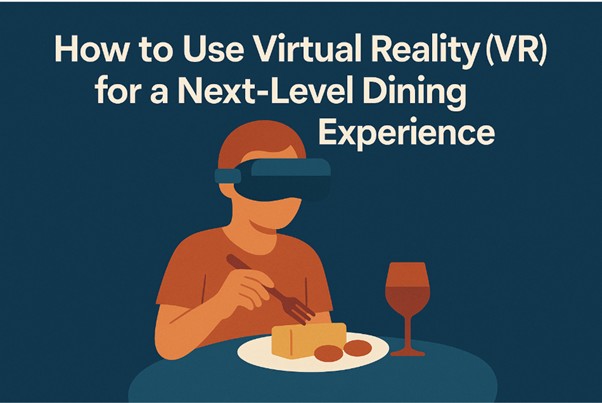
How to Use Virtual Reality (VR) for a Next-Level Dining Experience
The restaurant industry has always been about more than just food. It’s about storytelling, ambiance, and creating unforgettable moments. As we step into a more tech-forward future, restaurants are beginning to embrace a game-changing innovation: Virtual Reality (VR).
From immersive dining journeys to virtual tours of farms and kitchens, VR is helping restaurateurs redefine hospitality. Chef Shajahan M Abdul, founder of Restro Consultants Pvt Ltd (RCPL), said, “Virtual reality adds a fourth dimension to the dining experience—emotionally and digitally. When used right, it doesn’t just entertain; it connects.”
Let’s explore how VR can
elevate your restaurant experience—and how to implement it effectively.
What Is Virtual Reality (VR) in
the Context of Dining?
In restaurants, VR refers to using
headsets or immersive projection to place diners in a virtual environment that
enhances their sensory experience. This could include:
Restaurant consultants work
closely with tech firms to bring these visions to life in restaurants across
India and beyond.
Why Virtual Reality Is the Next
Big Thing in Dining
1. It Creates Emotional
Engagement
VR stimulates multiple senses,
not just taste. When emotionally engaged, customers remember more and return
more often.
Chef Abdul explains, “People
forget the price but never forget how you made them feel. VR helps you create
feelings.”
2. It Tells Your Brand Story in
a Powerful Way
Showcase your farm-to-table
ethics, chef’s journey, or cultural inspiration behind your dishes—visually and
viscerally.
3. It Encourages Sharing and
Word of Mouth
A guest who experiences a 360°
trip to Tuscany while eating Italian cuisine will likely post about it,
building organic reach and buzz.
Restro Consultants Pvt Ltd
(RCPL) has already piloted VR concepts for multiple premium restaurants seeking
differentiation.
Top VR Applications in
Restaurants
A. Virtual Travel Dining
Allow guests to
“travel” to the place where their dish originated. Imagine eating
ramen while virtually sitting at a Tokyo street stall.
B. Chef-Led Cooking Experiences
Guests wear headsets and follow
along as Chef Shajahan M Abdul explains how their dish was prepared.
C. Immersive Themed
Environments
Fine-dining restaurants can
transport guests to outer space, an underwater world, or an ancient
palace—perfect for anniversaries or luxury tastings.
D. Virtual Menu Previews
Let guests view dishes in 3D
before ordering. They can rotate, zoom, and even hear a steak sizzle or a dosa
crackle.
Restaurant consultants at RCPL
say that interactive menus reduce order indecision and increase upsells of
high-margin items.
How to Implement VR in Your
Restaurant
1. Start with One Experience
Pick a signature dish or dining
package and build a VR story around it. Don’t try to launch with a full VR menu
on day one.
2. Invest in the Right Gear
Options range from affordable
cardboard viewers paired with mobile apps to full-scale Oculus or Meta
headsets. Select based on your audience and restaurant type.
3. Work with VR Content
Creators
Collaborate with visual
storytellers who understand food, movement, and sensory cues. Chef Abdul
recommends using real footage over animation for authenticity.
4. Train Your Staff
Your team should be able to:
Restro Consultants Pvt Ltd
(RCPL) also offers SOPs and training modules tailored for tech-integrated
hospitality.
Cost vs. ROI: Is VR Worth It?
Implementing VR may sound
expensive, but it doesn’t have to be.
Low-budget options:
High-end options:
Chef Shajahan M Abdul states,
“When you offer a story no one else can, price becomes secondary. Guests pay
for meaning, not just meals.”
Success Stories from RCPL
Projects
Challenges to Keep in Mind
Restaurant consultants at RCPL
can help tailor the right VR experience for your space, budget, and brand
story.
Final Thoughts from Chef
Shajahan M Abdul
Virtual reality is no longer
science fiction—it’s the next evolution of hospitality. Used creatively, VR can
help your restaurant stand out, deepen emotional connections, and create
unforgettable moments that guests will talk about long after the bill is paid.
As Chef Shajahan M Abdul puts it:
“Great food satisfies hunger. Great experiences satisfy memory. Virtual reality
lets you serve both—on the same plate.”
With expert planning and tech
integration from restaurant consultants at Restro Consultants Pvt Ltd (RCPL),
your restaurant can lead the next wave of immersive, next-level dining in India
and beyond.
Chef Abdul © Copyright 2024. All rights reserved.